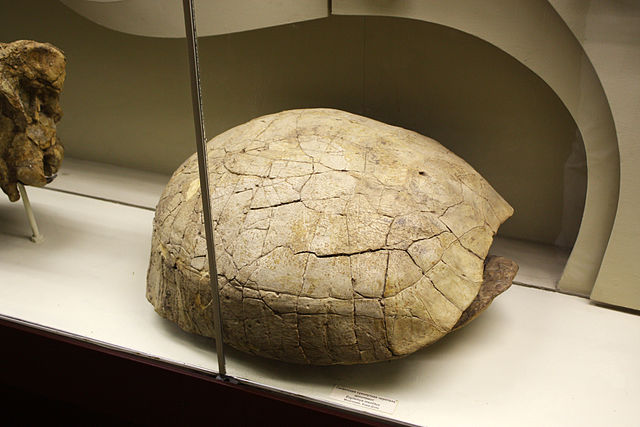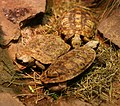Top Qs
Linha do tempo
Chat
Contexto
Testudinídeos
Da Wikipédia, a enciclopédia livre
Remove ads
Os testudinídeos (Testudinidae), dentro da ordem Testudines, são uma família biológica que engloba todas as espécies de tartarugas terrestres,[1] entre as quais os jabutis.[2] Como todos os quelónios, os testudinídeos têm o corpo protegido por uma carapaça e plastrão. As tartarugas terrestres podem apresentar, conforme a espécie, dimensões muito variáveis, desde alguns centímetros até mais de um metro. A sua dieta é herbívora, embora nalguns casos se alimentem também de carne (por exemplo todas as espécies do género Kinixys). Geralmente, podem viver até idades muito avançadas e por isso representam símbolos de longevidade em diversas culturas. Os animais mais velhos registados na terra foram três tartarugas terrestres: Tu'i Malila, que morreu em 1967, aos 188 anos; Adwaita, que morreu em 2006 entre os 150 e os 250 anos; e Harriet que morreu também em 2006 com uma idade estimada em 175 anos.[3]
Remove ads
Taxonomia
Resumir
Perspectiva

A família Testudinidae foi tradicionalmente dividida em duas subfamílias, Testudininae Gray, 1825 e Xerobatinae Agassiz, 1857, entretanto, análises filogenéticas não reconhecem nenhuma subdivisão para a família.[4]

Esta lista de espécies segue em grande parte o Turtle Taxonomy Working Group (2021)[5] e o Turtle Extinctions Working Group (2015).[6]


Família Testudinidae Batsch 1788[7]
- †Alatochelon[8]
- † Alatochelon myrteum
- Aldabrachelys Loveridge and Williams 1957:166[9] [nota 1]
- Aldabrachelys gigantea Aldabran giant tortoise.
- †Aldabrachelys abrupta Holoceno tardio, extinto cerca de 1200 DC
- †Aldabrachelys grandidieri Holoceno tardio, extinto cerca de 884 DC
- Astrochelys Gray, 1873:4[11][nota 1]
- Astrochelys radiata
- Astrochelys yniphora, Madagascar
- Centrochelys Gray 1872:5[12]
- † Centrochelys atlantica
- † Centrochelys burchardi, tartaruga gigante de Tenerife[13]
- † Centrochelys marocana
- † Centrochelys robusta
- Centrochelys sulcata
- † Centrochelys vulcanica
- Chelonoidis Fitzinger 1835:112[14][nota 1]
- † Chelonoidis alburyorum Tartaruga ábaco, Pleistoceno tardio, extinto c. 1400 dC
- Chelonoidis carbonaria, jabuti-piranga
- Chelonoidis chilensis, tartaruga do Chaco
- † Chelonoidis cubensis Tartaruga gigante cubana
- Chelonoidis denticulatus Jabuti-tinga
- † C. dominicensis Tartaruga gigante dominicana[15]
- † Chelonoidis lutzae Tartaruga gigante de Lutz, Pleistoceno tardio
- † Chelonoidis monensis
- Chelonoidis nigra Tartaruga-das-galápagos[16]
- † Chelonoidis sellovii Tartaruga gigante do Cone Sul, Pleistoceno
- † Chelonoidis sombrerensisTartaruga gigante sombrero, final do Pleistoceno
- Chersina Gray 1830:5
- † Cheirogaster Bergounioux 1935:78
- †Cheirogaster gymnesicaPlioceno Superior ao Pleistoceno Inferior
- †Cheirogaster schafferiPlioceno ao Pleistoceno Inferior
- Chersobius Fitzinger, 1835
- Chersobius boulengeri,
- Chersobius signatus
- Chersobius solus
- †Cylindraspis Fitzinger 1835:112[14] (todas as espécies extintas) segundo Austin e Arnold, 2001.[17][nota 1]
- †Cylindraspis indica, sinônimo Cylindraspis borbonica, Tartaruga gigante de Reunião
- †Cylindraspis inepta, Tartaruga gigante da Maurícia de sela ou Tartaruga gigante abobadada da Maurícia
- †Cylindraspis peltastes, tartaruga gigante abobadada de Rodrigues
- †Cylindraspis triserrata, Tartaruga gigante da Maurícia abobadada ou tartaruga gigante de carapaça chata da Maurícia
- †Cylindraspis vosmaeri, tartaruga-gigante-de-rodrigues-sela
- † Ergilemys Ckhikvadze, 1984[18]
- Ergilemys bruneti
- Ergilemys insolitus
- Ergilemys saikanensis
- Geochelone Fitzinger 1835:112[14]
- † Geochelone vulcanica tartaruga gigante da Gran Canária[19]
- Geochelone elegans, tartaruga estrelada indiana
- Geochelone platynota, tartaruga estrelada da Birmânia
- † Geochelone robusta tartaruga gigante de Malta
- Gopherus Rafinesque 1832:64[20]
- Gopherus agassizii, Tartaruga do deserto de Mojave, Tartaruga do deserto de Agassiz
- Gopherus berlandieri, tartaruga do Texas
- Gopherus flavomarginatus, tartaruga de Bolson
- Gopherus morafkai
- Gopherus polyphemus
- † Hadrianus
- Hadrianus corsoni (syn. H. octonarius)
- Hadrianus robustus
- Hadrianus schucherti
- Hadrianus utahensis
- † Hesperotestudo
- Hesperotestudo alleni
- Hesperotestudo angusticeps
- Hesperotestudo brontops
- Hesperotestudo equicomes
- Hesperotestudo impensa
- Hesperotestudo incisa
- Hesperotestudo johnstoni
- Hesperotestudo kalganensis
- Hesperotestudo niobrarensis
- Hesperotestudo orthopygia
- Hesperotestudo osborniana
- Hesperotestudo percrassa
- Hesperotestudo riggsi
- Hesperotestudo tumidus
- Hesperotestudo turgida
- Hesperotestudo wilsoni
- Homopus Duméril e Bibron 1834:357[21]
- Homopus areolatus, tartaruga do Cabo
- Homopus femoralis
- Indotestudo Lindholm, 1929[nota 1]
- Kinixys
- Kinixys belliana
- Kinixys erosa
- Kinixys homeana
- Kinixys lobatsiana
- Kinixys natalensis
- Kinixys spekii
- Malacochersus Lindholm 1929:285[22]
- Malacochersus tornieri, tartaruga panqueca
- Manouria Gray 1854:133[23][nota 1]
- Manouria emys
- Manouria impressa
- † Megalochelys Falconer, H. and Cautley, P.T. 1837.[24]
- † Megalochelys atlas, Tartaruga do Atlas, Extinta – Plioceno ao Pleistoceno
- † Megalochelys cautleyi, tartaruga gigante de Cautley
- Psammobates Fitzinger 1835:113[14]
- Psammobates geometricus, tartaruga geométrica
- Psammobates oculifer, Tartaruga de tenda serrilhada, Tartaruga de tenda de Kalahari
- Psammobates tentorius, tartaruga de tenda africana
- Pyxis Bell 1827:395[25]
- Pyxis arachnoides
- Pyxis planicauda, tartaruga-aranha-de-cauda-chata, (Madagascan) tartaruga-de-cauda-chata, tartaruga-aranha-de-cauda-chata
- Stigmochelys Gray, 1873
- Stigmochelys pardalis, tartaruga leopardo
- † Stylemys
- Stylemys botti
- Stylemys calaverensis
- Stylemys canetotiana
- Stylemys capax
- Stylemys conspecta
- Stylemys copei
- Stylemys emiliae
- Stylemys frizaciana
- Stylemys karakolensis
- Stylemys nebrascensis (syn. S. amphithorax)
- Stylemys neglectus
- Stylemys oregonensis
- Stylemys pygmea
- Stylemys uintensis
- Stylemys undabuna
- † Titanochelon
- †Titanochelon gymnesica (Bate, 1914) Ilhas Baleares, Plioceno
- † Titanochelon bolivari (Hernandez-Pacheco, 1917) (tipo) Península Ibérica, Mioceno
- † Titanochelon bacharidisi (Vlachos et al., 2014) Grécia, Bulgária, final do Mioceno
- † Titanochelon perpiniana (Deperet 1885) França, Mioceno
- †Titanochelon schafferi (Szalai, 1931) Samos, Grécia, Mioceno
- †Titanochelon vitodurana (Biedermann 1862) Suíça, início do Mioceno
- †Titanochelon kayadibiensis Karl, Staesche & Safi, 2021, Anatólia, Mioceno
- †Titanochelon eurysternum (Gervais, 1848–1852) França, Mioceno
- †Titanochelon ginsburgi (de Broin, 1977 ) França, Mioceno
- †Titanochelon leberonensis (Depéret, 1890) França, Mioceno
- Testudo
- Testudo graeca, tartaruga grega
- Testudo hermanni, Hermann's tortoise
- Testudo horsfieldii, tartaruga russa, também classificada como Agrionemys horsfieldii
- Testudo kleinmanni, tartaruga egípcia, incluindo a tartaruga do Negev
- Testudo marginata
Remove ads
Galeria de imagens
- Aldabrachelys gigantea, espécie nativa das Seychelles.
- Agrionemys horsfieldii, Ásia Central.
- Astrochelys radiata, do sul de Madagascar.
- Astrochelys yniphora, de Madagascar.
- Centrochelys sulcata, deserto do norte africano.
- Chelonoidis chilensis haplogrupo do Norte, tartaruga do chaco (América do Sul).
- Chelonoidis chilensis haplogrupo chaco seco, tartaruga do chaco (América do Sul).
- Chelonoidis denticulata, o jabuti-tinga, nativo do norte da América do Sul, eventualmente também do centro-oeste e sudeste do Brasil.
- Chelonoidis carbonaria, o jabuti-piranga, nativo da América do Sul continental, Sudeste do Panamá e Caribe.
- Geochelone elegans, nativa da Índia e Sri Lanka.
- Geochelone platynota, nativa de Mianmar.
- Gopherus flavomarginatus, ou tartaruga de Bolson, do México.
- Gopherus morafkai, sudoeste dos Estados Unidos e noroeste do México.
- Gopherus polyphemus, Estados Unidos.
- Indotestudo elongata, Sudeste asiático e Índia.
- Indotestudo travancorica, Índia.
- Kinixys belliana, África do Sul.
- Malacochersus tornieri, a tartaruga panqueca, do sul do Quênia e norte da Tanzânia.
- Manouria emys, Sudeste da Ásia.
- Psammobates geometricus, África do Sul.
- Pyxis arachnoides, Madagascar.
- Pyxis planicauda, Madagascar.
- Stigmochelys pardalis, a tartaruga leopardo, leste da África.
- Testudo graeca, sul da Europa, leste da Europa, oeste da Ásia e norte da África.
- Testudo hermanni, sul da Europa.
- Testudo kleinmanni, Egito e Líbia.
Remove ads
Referências
- Caio A Carbonaro Guerreiro. «Que tipos de tartarugas terrestres existem?». Consultado em 2 de maio de 2023. Cópia arquivada em 2 de maio de 2023
- Porto Editora – jabuti no Dicionário infopédia da Língua Portuguesa sem Acordo [em linha]. Porto: Porto Editora. [consult. 2023-05-02 14:05:13]. Disponível em https://www.infopedia.pt/dicionarios/lingua-portuguesa-aao/jabuti
- Jorge Andrade (8 de Fevereiro de 2021). «De onde veio Harriet? O enigma da tartaruga de estimação de Darwin». Diário de Notícias. Consultado em 25 de abril de 2022
- Le, 2006
- Rhodin, Anders G.J. (15 de novembro de 2021). Turtles of the World: Annotated Checklist and Atlas of Taxonomy, Synonymy, Distribution, and Conservation Status (9th Ed.). Col: Chelonian Research Monographs. 8. [S.l.]: Chelonian Research Foundation and Turtle Conservancy. ISBN 978-0-9910368-3-7. doi:10.3854/crm.8.checklist.atlas.v9.2021
- Rhodin, A.G.J.; Thomson, S.; Georgalis, G.; Karl, H.-V.; Danilov, I.G.; Takahashi, A.; de la Fuente, M.S.; Bourque, J.R.; Delfino M.; Bour, R.; Iverson, J.B.; Shaffer, H.B.; van Dijk, P.P.; et al. (Turtle Extinctions Working Group) (2015). Turtles and tortoises of the world during the rise and global spread of humanity: first checklist and review of extinct Pleistocene and Holocene chelonians. Col: Chelonian Research Monographs, 8. 5. [S.l.: s.n.] pp. 000e.1–66. ISBN 978-0965354097. doi:10.3854/crm.5.000e.fossil.checklist.v1.2015

- Adán Pérez‐García; Evangelos Vlachos; Xabier Murelaga (2020). «A large testudinid with African affinities in the post‐Messinian (lower Pliocene) record of south‐eastern Spain». Palaeontology. 63 (3): 497–512. doi:10.1111/pala.12468
- Loveridge, Arthur; Williams, Ernest E. (1957). «Revision of the African tortoises and turtles of the suborder Cryptodira». Bulletin of the Museum of Comparative Zoology. 115 (6): 163–557
- Atlas Virtual da Pré-História. «Jabuti Piranga». Consultado em 7 de junho de 2016
- Gray, John Edward (1873). «Notes on the genera of turtles (Oiacopodes), and especially on their skeletons and skulls». Proceedings of the Zoological Society of London. 1873: 395–411
- Gray, John Edward. (1872). "Appendix to the Catalogue of Shield Reptiles in the Collection of the British Museum. Part I. Testudinata (Tortoises)". London: British Museum, 28 pp.
- «The Recently Extinct Plants and Animals Database cubit: The Recently Extinct Plants and Animals Database Extinct Reptiles: Geochelone burchardi». cubits.org. Consultado em 17 de junho de 2016. Arquivado do original em 19 de junho de 2016
- Fitzinger, Leopold J. (1835). «Entwurf einer systematischen Anordnung der Schildkröten nach den Grundsätzen der natürlichen Methode». Annalen des Wiener Museums der Naturgeschichte. 1: 105–128
- «Fossilworks: Chelonoidis dominicensis». fossilworks.org. Consultado em 17 de dezembro de 2021
- Testudinidae, The Reptile Database
- Austin, J. J.; Nicholas Arnold, E. (2001). «Ancient mitochondrial DNA and morphology elucidate an extinct island radiation of Indian Ocean giant tortoises (Cylindraspis)». Proceedings of the Royal Society B: Biological Sciences. 268 (1485): 2515–23. PMC 1088909
 . PMID 11749704. doi:10.1098/rspb.2001.1825
. PMID 11749704. doi:10.1098/rspb.2001.1825 - «Ergilemys». paleobiodb.org. Paleobio DB. Consultado em 23 de março de 2022
- «The Recently Extinct Plants and Animals Database cubit: The Recently Extinct Plants and Animals Database Extinct Reptiles: Geochelone vulcanica». cubits.org. Consultado em 17 de junho de 2016. Arquivado do original em 24 de junho de 2016
- Rafinesque, Constantine Samuel (1832). «Description of two new genera of soft shell turtles of North America». Atlantic Journal and Friend of Knowledge. 1: 64–65
- Duméril, André Marie Constant and Bibron, Gab riel. 1834. Erpétologie Générale ou Histoire Naturelle Complète des Reptiles. Tome Premier. Paris: Roret, 439 pp.
- Lindholm, Wassili A. (1929). «Revidiertes Verzeichnis der Gattungen der rezenten Schildkröten nebst Notizen zur Nomenklatur einiger Arten». Zoologischer Anzeiger. 81: 275–295
- Gray, John Edward (1834). «Characters of several new species of freshwater tortoises (Emys) from India and China». Proceedings of the Zoological Society of London. 2: 53–54
- Falconer, H.; Cautley, P.T. (1837). «On additional fossil species of the order Quadrumana from the Siwalik Hills». Journal of the Asiatic Society of Bengal. 6: 354–360
- Bell, T. (1827). «XVI. On two new Genera of Land Tortoises» (PDF). Transactions of the Linnean Society of London. 15 (2): 392–401. doi:10.1111/j.1095-8339.1826.tb00122.x. Consultado em 28 de agosto de 2015. Arquivado do original (PDF) em 5 de setembro de 2018
Remove ads
Notas
Wikiwand - on
Seamless Wikipedia browsing. On steroids.
Remove ads

































